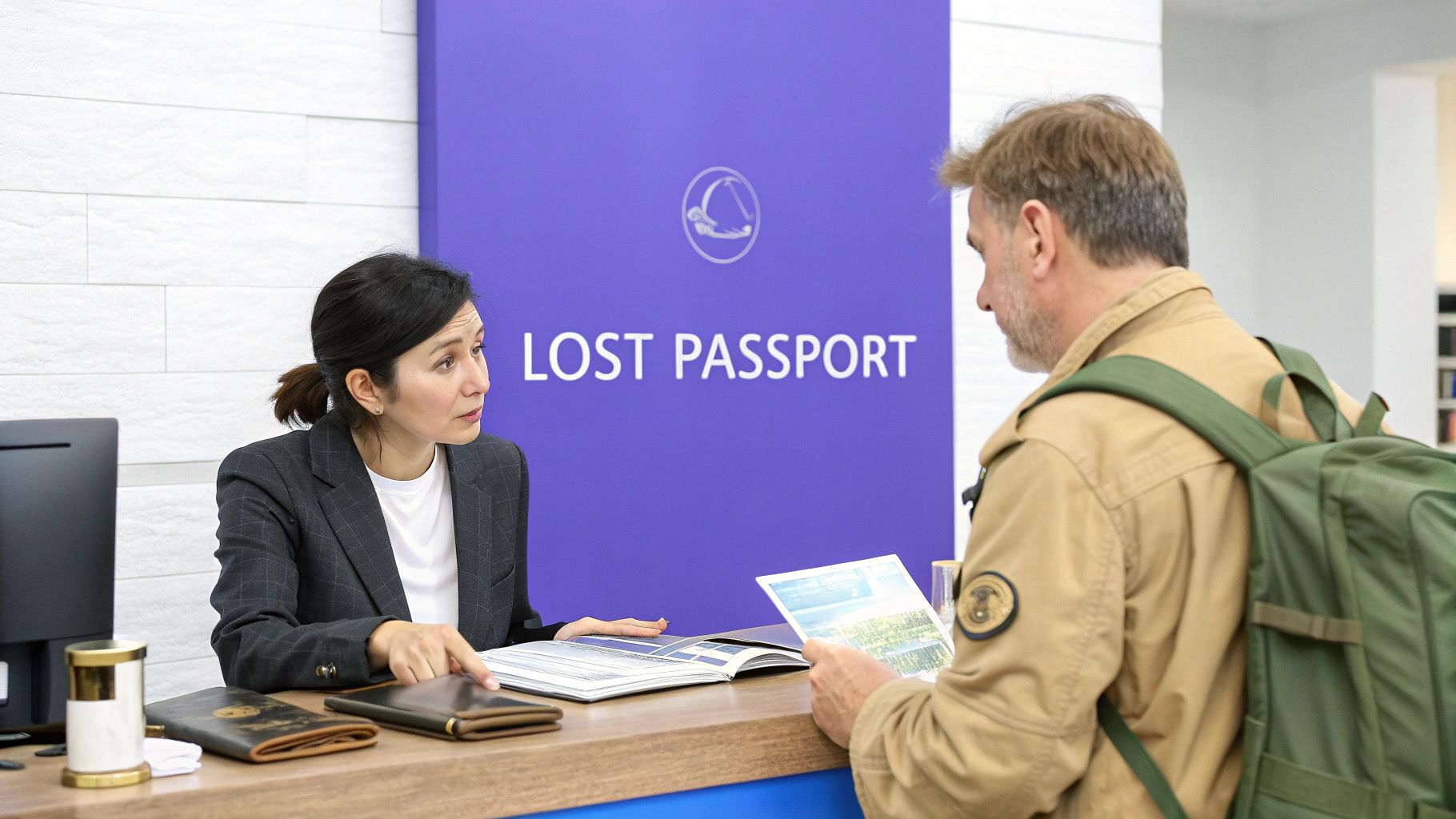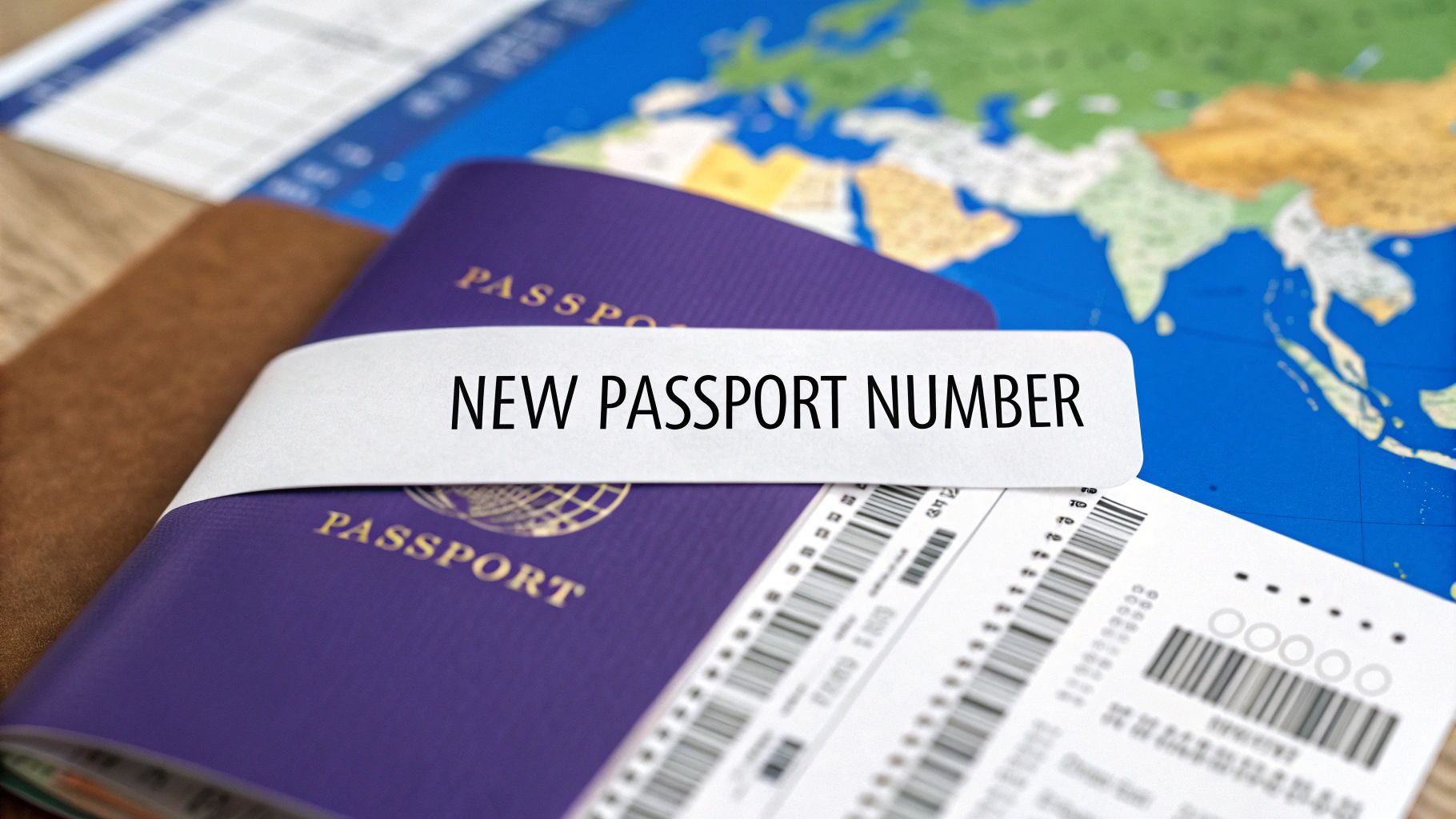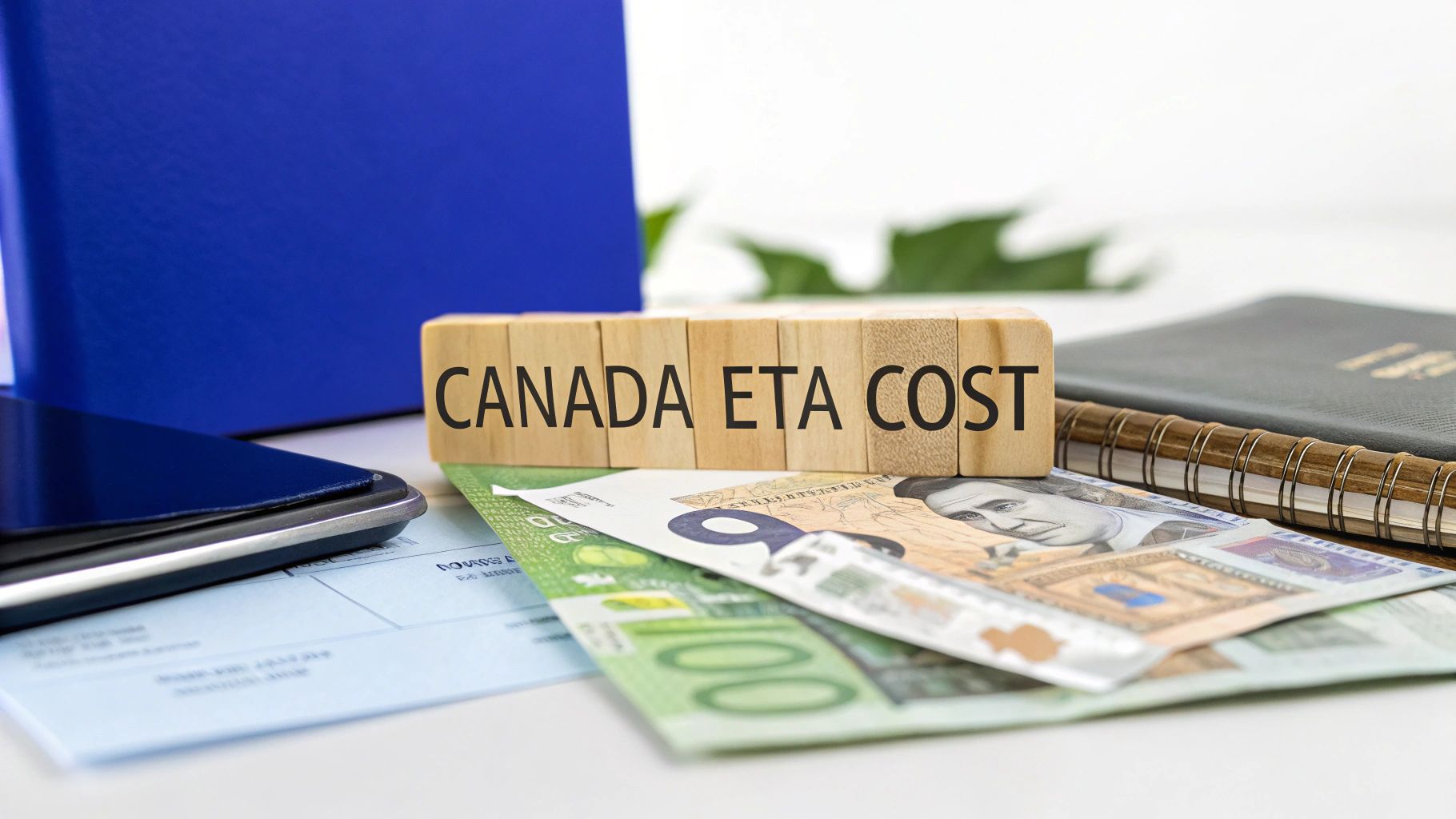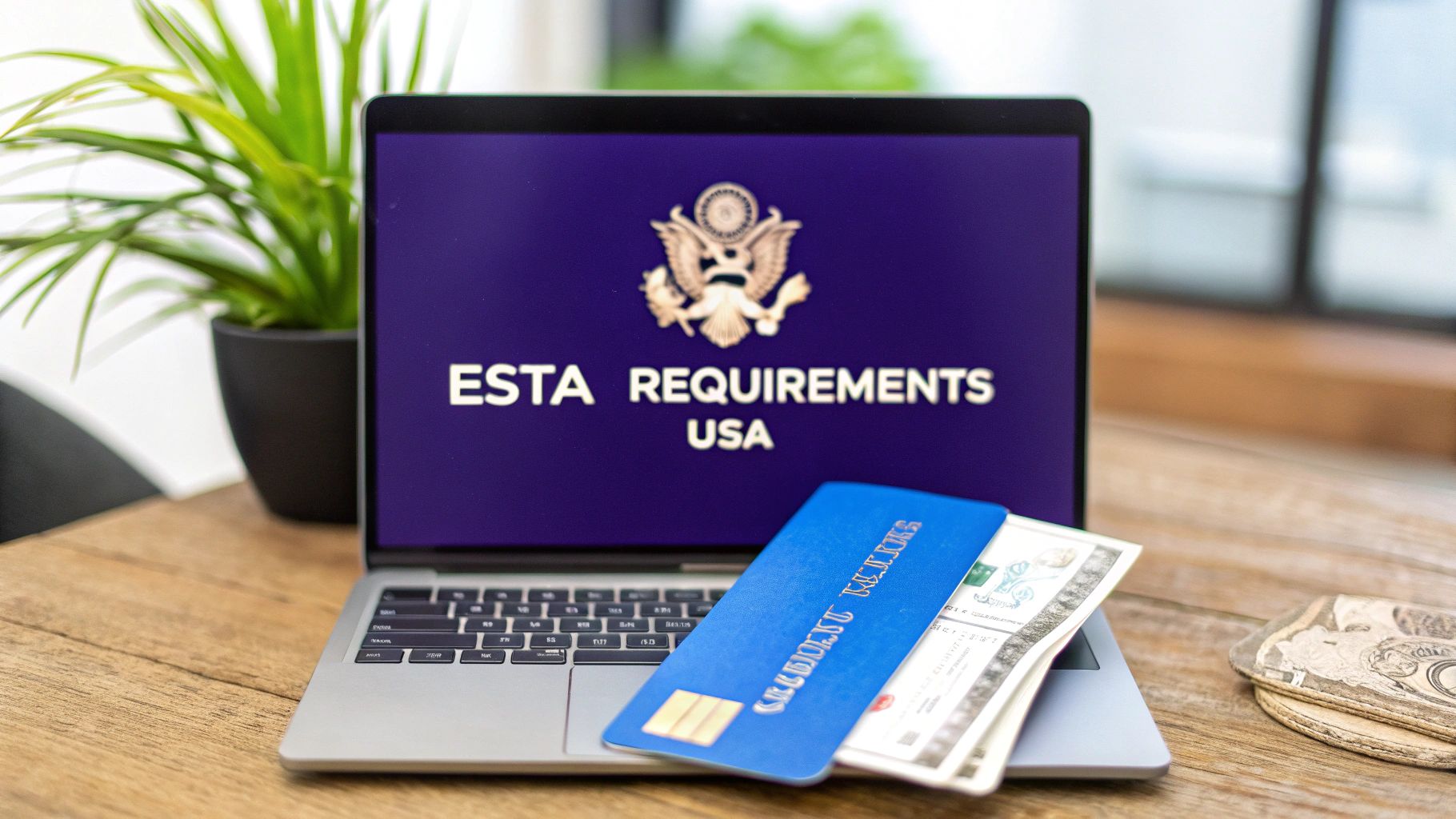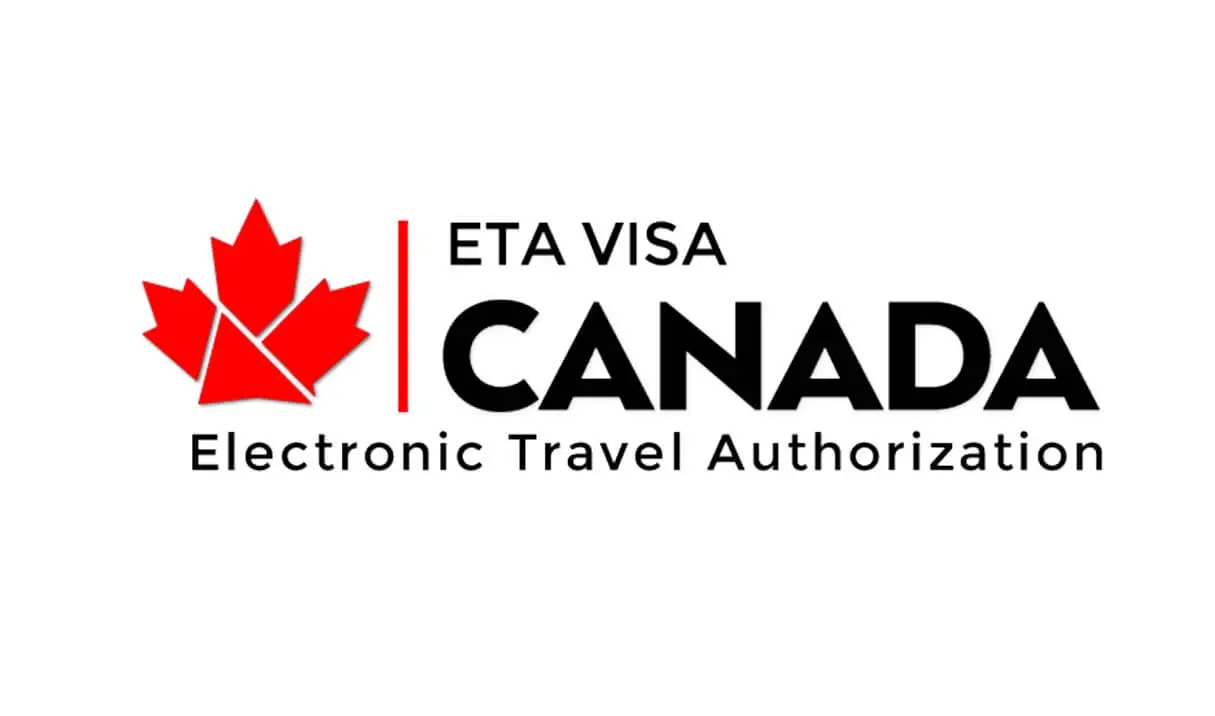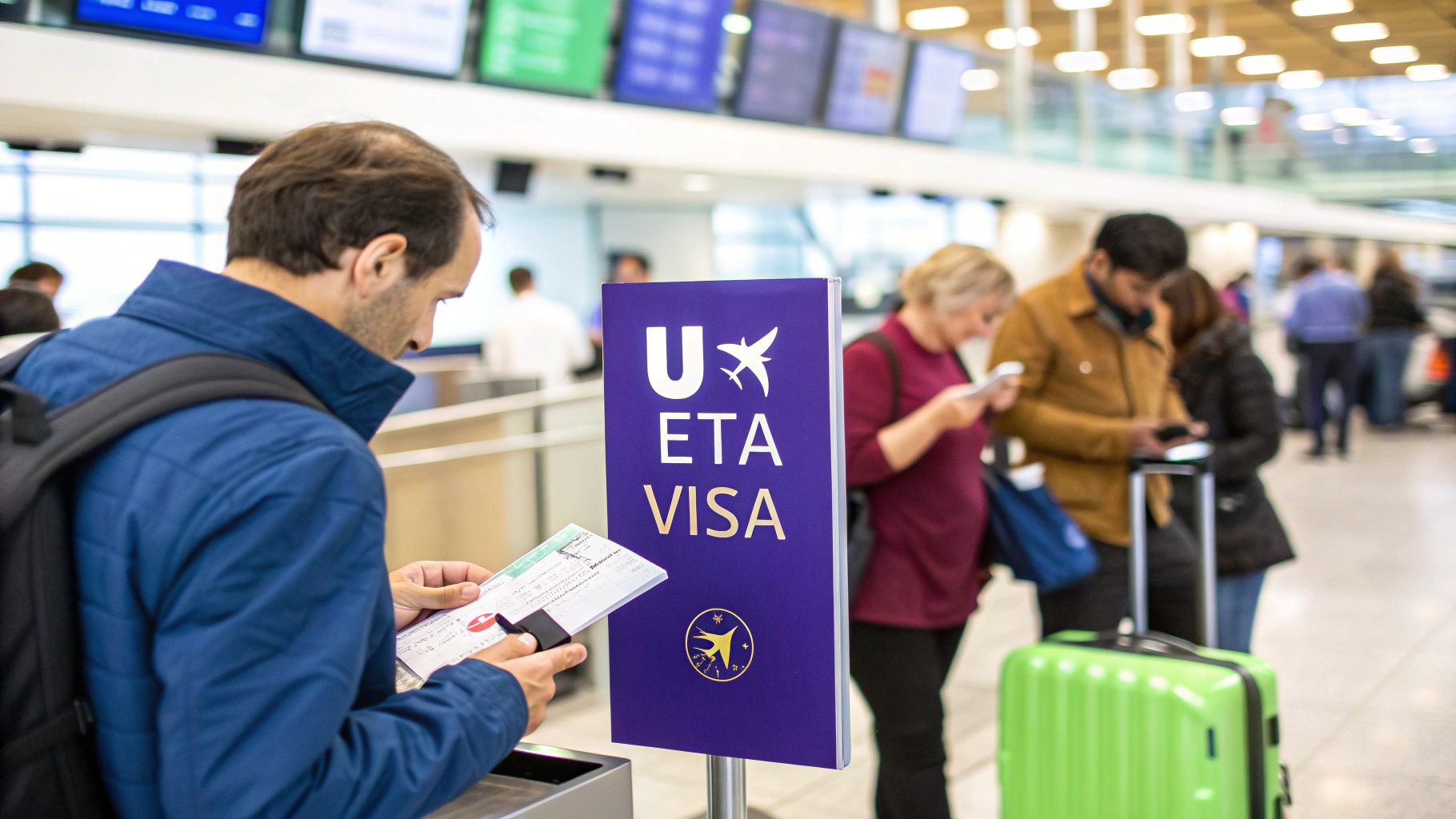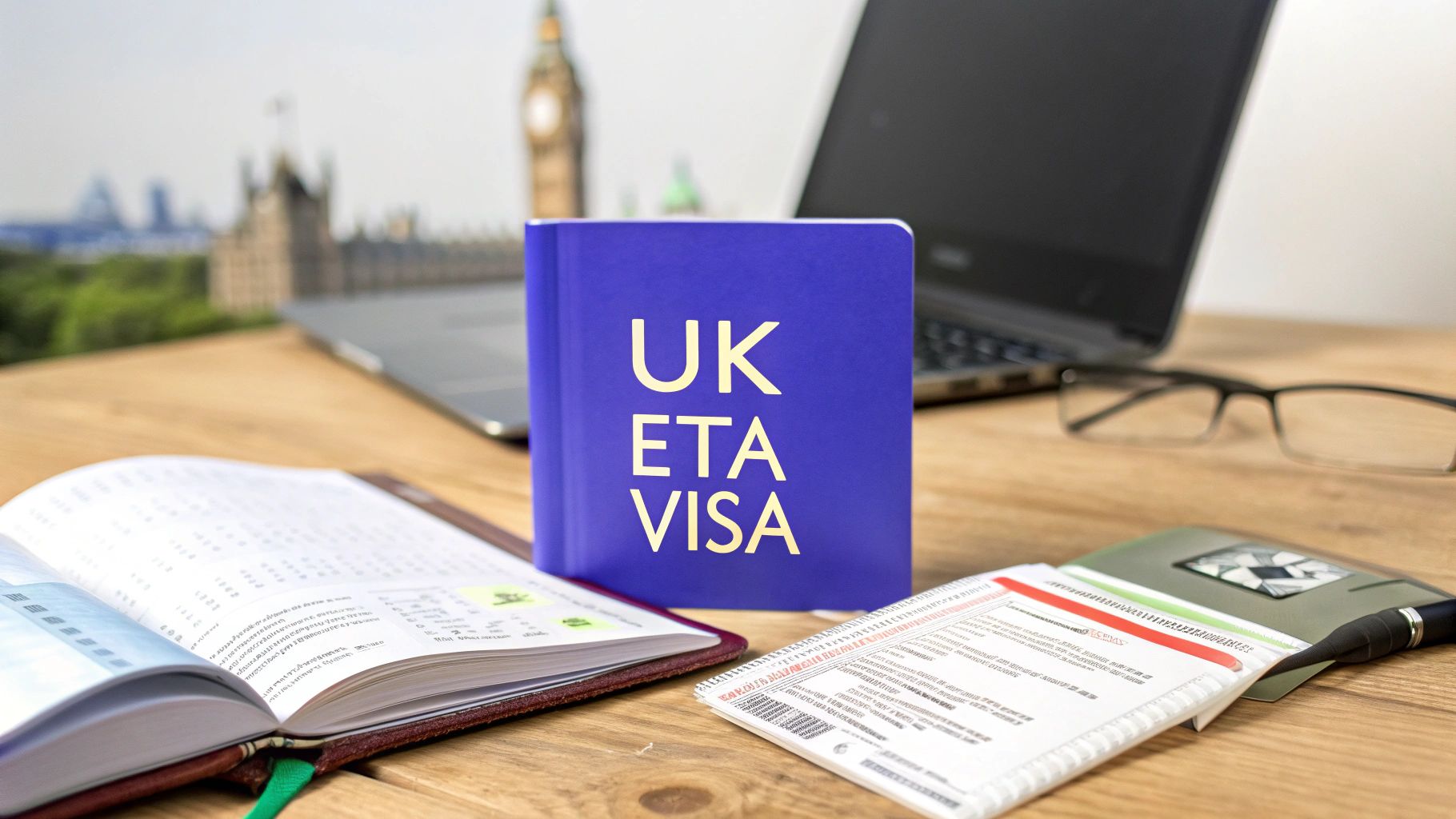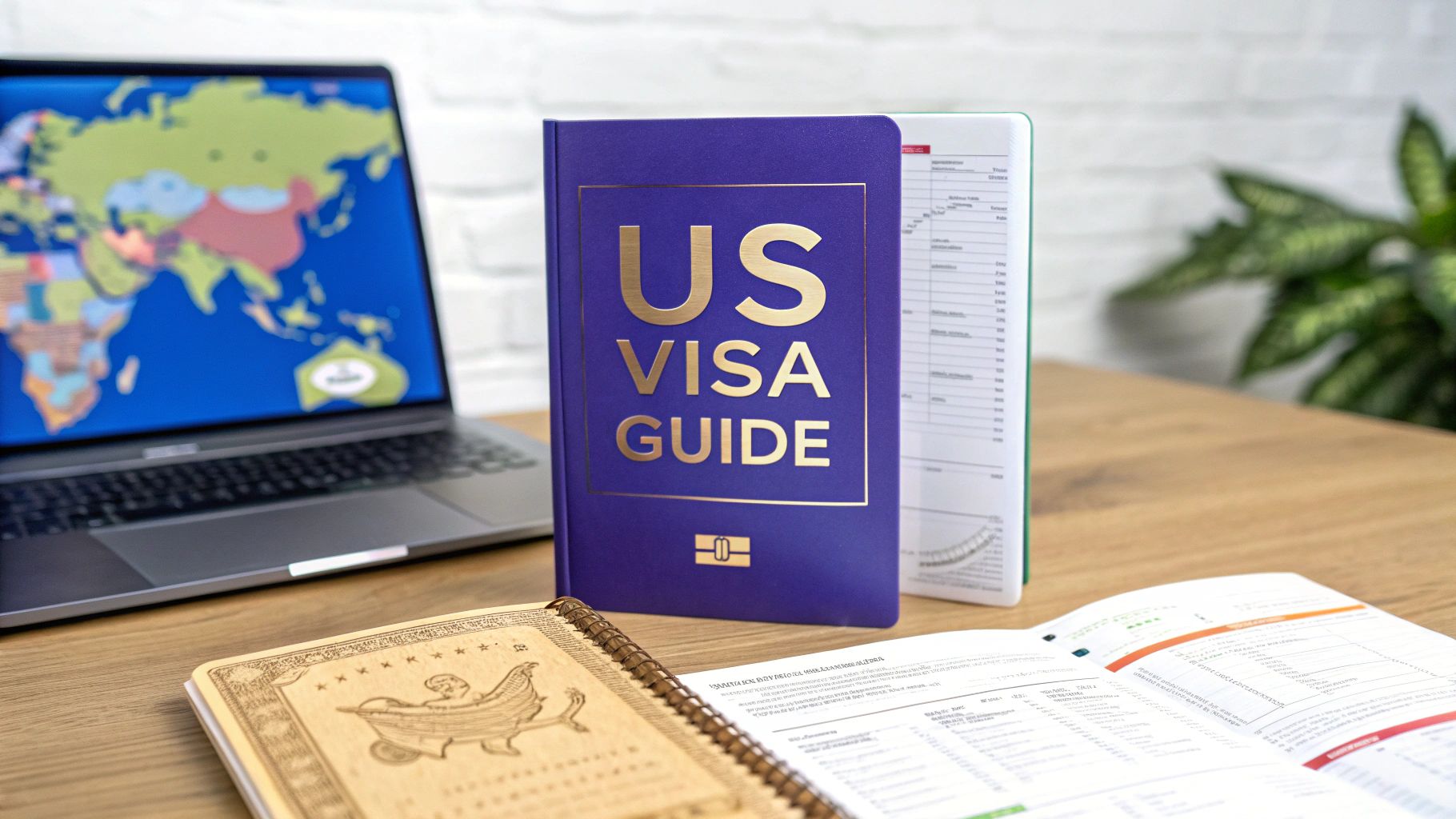
Your Guide to Getting a US Visa
So, what exactly is a US visa? Think of it as a pre-approval slip tucked into your passport. It shows that a U.S. official at an embassy or consulate has reviewed your case and believes you're eligible to travel to the United States for a specific reason.
But here’s the key thing to remember: a visa doesn't automatically open the door. It gets you to the front of the line, but the final say on whether you can enter the country belongs to the Customs and Border Protection (CBP) officers you meet at the airport.
Starting Your US Visa Journey
Getting started with a US visa can feel like you're staring at a giant, confusing map with no "you are here" marker. There are dozens of categories, endless forms, and a whole new vocabulary to learn. It's easy to get lost.
The best way to find your bearings is to understand one simple, foundational idea: the entire system is built around your reason for traveling. Are you planning a short vacation, or are you moving to the US for good? Nailing this down from the very beginning is the single most important thing you can do to avoid headaches, delays, and even a denial later on.
Immigrant vs. Nonimmigrant Visas
Every US visa falls into one of two major lanes. Figuring out which lane is yours is the first real step on your application journey.
Nonimmigrant Visas: These are for temporary trips. If you're coming to the U.S. for a vacation, a business conference, to study at a university, or for temporary work, you're in the nonimmigrant lane. Think B-2 for tourism or F-1 for students. For any of these, your main job is to prove nonimmigrant intent—basically, convincing the consular officer that you have strong ties to your home country and will leave the U.S. when your visit is over.
Immigrant Visas: This lane is for people who plan to make the United States their permanent home. An immigrant visa is your ticket to getting a Green Card and becoming a Lawful Permanent Resident. These are almost always sponsored by a close family member who is a U.S. citizen or a U.S. employer.
The core difference is all about your long-term plans. A nonimmigrant visa is like a temporary pass for a specific event. An immigrant visa is the first step toward getting a new set of keys to a permanent home.
Why This Distinction Matters
You absolutely must choose the right category. There's no gray area here. For example, trying to get a tourist visa when you actually plan to stay and find a job is considered visa fraud. That’s a serious offense that could get you permanently banned from ever entering the U.S. Consular officers are trained professionals whose job is to spot inconsistencies between what an applicant says and what their real plans might be.
So, your first task is simple: get crystal clear on why you’re going. Are you booking a two-week trip to see the Grand Canyon, or are you moving to join your American spouse? The answer to that question will light up your path forward. For a deeper dive into the specific requirements for each, our guide on the US visa application process breaks it all down.
Decoding the Most Common US Visa Types
Navigating the world of US visas can feel like trying to learn a new language, one filled with confusing codes and complex categories. But getting it right is crucial. Applying for the wrong visa is one of the most common—and costly—mistakes you can make.
The entire system really boils down to one simple question: what’s the main reason for your trip? Every visa is designed for a specific purpose, whether it’s a quick vacation, a long-term job, or a permanent move. Choose the right category from the start, and you'll align your application with your true intentions, which seriously boosts your odds of success.
Let's break down the most common visa types into plain English.
Nonimmigrant Visas for Temporary Stays
Nonimmigrant visas are for anyone planning a temporary stay in the United States. The absolute key here is proving something called "nonimmigrant intent." In simple terms, you have to show that you have strong ties to your home country—like a job, family, or property—that will pull you back home after your visit is over.
This visual decision tree is a great starting point. It helps clarify whether your travel plans fall under a temporary or permanent stay, pointing you in the right direction from the get-go.
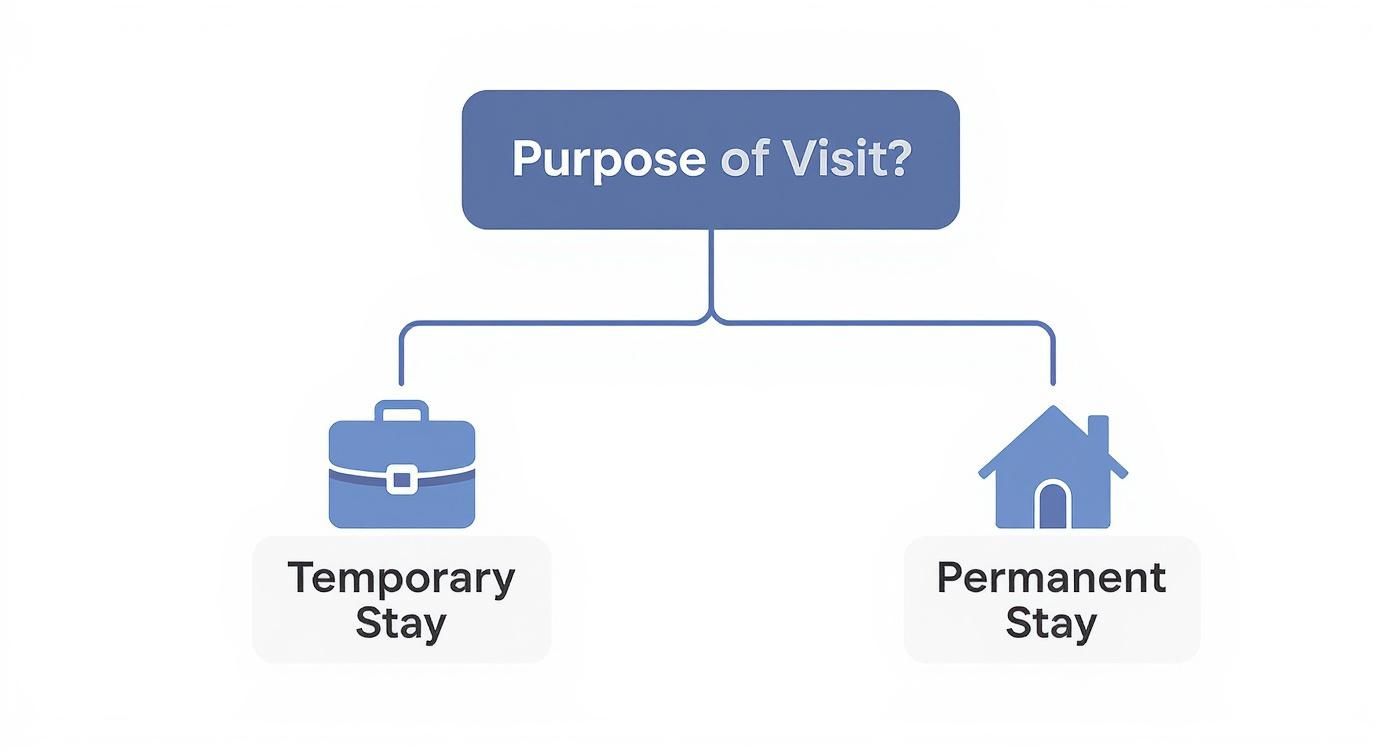
This flowchart simplifies that first big choice by separating visas based on intent, which is the most critical distinction in the entire process.
B-1/B-2 Visitor Visa
This is the one most people have heard of, often just called the "tourist visa." It's actually a combination of two separate categories:
- B-1 Visa: For business-related trips like attending a conference, negotiating a contract, or meeting with business partners.
- B-2 Visa: For tourism, vacation, visiting family and friends, or getting medical treatment.
Most people get a combined B-1/B-2 visa, which offers more flexibility. The golden rule, however, is that you absolutely cannot do any paid work on this visa. A Customs and Border Protection (CBP) officer will typically grant a stay of up to six months when you arrive.
F-1 Student Visa
The F-1 visa is specifically for international students accepted into a full-time academic program at a US school, college, or university. To get one, you’ll need to prove you have enough money to cover tuition and living costs and that you'll be a full-time student. F-1 holders can generally stay for as long as their academic program lasts.
H-1B Visa for Specialty Occupations
The H-1B is a work visa designed for professionals in "specialty occupations"—fields like tech, engineering, or finance that usually require a bachelor's degree or higher. This one is incredibly popular and competitive. Because demand is so much higher than the 85,000 visas available each year, there's an annual lottery to get one. An H-1B is usually granted for up to three years and can be extended.
Key Takeaway: The foundation of any nonimmigrant visa application is proving you will leave the U.S. when your authorized stay ends. Consular officers are trained to look for evidence of strong economic and social ties to your home country.
For some travelers, the Visa Waiver Program might be a simpler option for short trips. While the US uses the ESTA system, other countries like the UK and Canada have similar Electronic Travel Authorization (ETA) programs.
Immigrant Visas for Permanent Residence
Immigrant visas are the gateway to living permanently in the United States. They are the first official step toward getting a Green Card (Lawful Permanent Residence). As you can imagine, these applications are much more complex and take a lot longer to process than nonimmigrant visas.
Family-Based Immigrant Visas
These visas are for close relatives of US citizens and Lawful Permanent Residents (LPRs). The system is broken down into a couple of main groups:
- Immediate Relatives (IR): This includes spouses, unmarried children under 21, and parents of US citizens. The good news is there are no annual limits on these visas, so the process is generally faster.
- Family Preference Categories (F): This is for more distant family members, like married children of US citizens or spouses of LPRs. These categories have strict annual caps, which often lead to very long waits.
Employment-Based Immigrant Visas
These visas are for foreign workers with specific, in-demand skills. They're divided into five preference categories (EB-1 through EB-5), each with its own set of requirements:
- EB-1: For people with extraordinary abilities, top-tier professors, and multinational executives.
- EB-2: For professionals with advanced degrees or individuals with exceptional ability.
- EB-3: For skilled workers, professionals, and other workers.
This path almost always requires a job offer from a US employer who is willing to sponsor your visa petition. For certain applicants, like Canadians looking to work stateside, this detailed guide for Canadians working in the US, covering various visa types offers some fantastic, in-depth information.
Comparison of Common US Visa Types
To give you a clearer picture of how these visas stack up against each other, we've put together a simple comparison table. This should help you quickly see the key differences at a glance.
| Visa Type | Primary Purpose | Key Eligibility Requirements | Typical Duration |
|---|---|---|---|
| B-1/B-2 | Tourism, Business, Medical | Proof of funds, nonimmigrant intent, ties to home country | Up to 6 months per visit |
| F-1 | Academic Study | Acceptance at a SEVP-approved school, proof of funds | Duration of academic program |
| H-1B | Professional Work | Bachelor's degree (or equivalent), job offer in a specialty occupation | Initially up to 3 years |
| IR / F | Family Reunification | Qualifying relationship with a U.S. citizen or LPR | Permanent |
| EB-1/2/3 | Employment | Job offer, specific skills, or advanced degree | Permanent |
Hopefully, this breakdown makes it easier to identify which path might be the right one for your journey to the United States.
Your Step-By-Step Visa Application Roadmap
Applying for a US visa can feel like trying to solve a complicated puzzle. But if you break it down into smaller, manageable pieces, the whole process becomes much clearer. Think of this as your personal checklist to get you from start to finish.
Tackling it one step at a time turns a potentially overwhelming task into a series of simple actions. Let's walk through it.
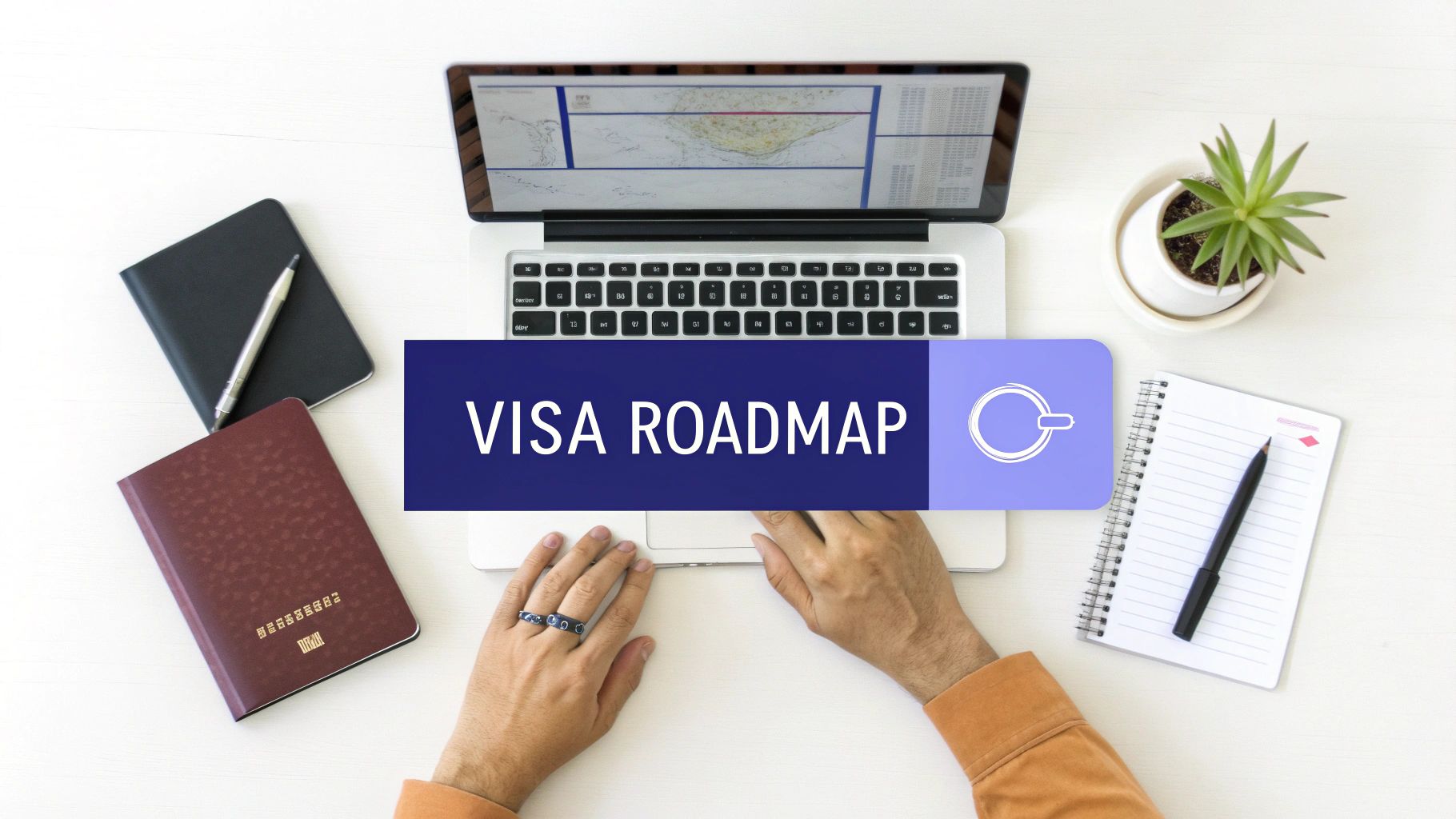
Step 1: Complete the DS-160 Online Form
Your journey officially kicks off with the DS-160, the Online Nonimmigrant Visa Application. This form is the foundation of your entire application, where you’ll enter all your personal, work, and travel details.
Accuracy here is everything. Even a tiny mistake can cause major delays or even get your application denied. Take your time, and double-check every single entry before you submit. Once it's sent, you can't go back and make changes. The confirmation page you get at the end is vital—you have to bring it to your interview.
Pro Tip: Before you even start the DS-160, get all your documents ready. Have your passport, travel itinerary, and a digital photo that meets the official requirements right next to you. This way, you won't have to stop mid-form and risk it timing out.
Step 2: Pay the Application Fee
After you’ve submitted the DS-160, it’s time to pay the non-refundable Machine-Readable Visa (MRV) fee. The cost depends on the type of visa you’re applying for, and how you can pay often varies by country.
Most of the time, you'll have a few options:
- Online Bank Transfer: This is usually the quickest and most common method.
- Cash at an Approved Bank: You'll need to print a specific deposit slip and take it to a bank the embassy has designated.
- Debit/Credit Card: Some consulates let you pay online with a card.
Always check the U.S. embassy or consulate website for your specific country to see what they require. Hang on to that payment receipt, because you'll need it to book your interview.
Step 3: Schedule Your Consular Interview
With your DS-160 confirmation and fee receipt ready, you can now book your interview. This is usually done by creating an account on the official U.S. visa services website for your country. From there, you can pick an available date and time for your appointment.
Heads up—interview wait times can be all over the place, depending on the location and how busy they are. Sometimes you might be waiting weeks or even months for an open slot, so it’s smart to get these first steps done long before you plan to travel.
Step 4: Gather Your Supporting Documents
While you're waiting for your interview date, use that time to get all your supporting documents in order. Your goal is to build a solid case that shows you're eligible for the visa and, just as importantly, that you plan to return home after your visit.
Here’s a quick checklist of what you'll need:
- Passport: It must be valid for at least six months past your planned stay in the U.S.
- DS-160 Confirmation Page: This is the one with the barcode.
- Application Fee Payment Receipt: Your proof of payment.
- Photo: One recent photo that meets the specific U.S. visa photo rules.
- Proof of Ties to Your Home Country: This is a big one. Think employment letters, property deeds, bank statements, or proof of family relationships.
- Purpose of Travel: This could be your travel itinerary, a letter of invitation from a friend or company, or an I-20 form if you're a student.
A strong cover letter can also make a big difference. If you're not sure how to write one, our guide on creating a cover letter for your visa application can help. And for those looking at a longer-term path, like permanent residency, hiring an Adjustment of Status Attorney is often a critical step to manage the complex legal side of things.
Step 5: Attend the Visa Interview
This is it—the most important part of the whole process. The interview is a brief, direct chat with a consular officer. Their job is to verify your application and understand your intentions. Expect questions about your trip, your job, your family, and your plans to return home.
The best approach? Be honest, clear, and confident. Listen to what they ask and give truthful answers. Remember, the officer has already read your DS-160, so your answers should match what you’ve already submitted.
Step 6: Await the Decision
Usually, the officer will tell you their decision right at the end of the interview. It'll be one of three outcomes:
- Approved: Great news! The officer keeps your passport to put the visa inside. It will be sent back to you via courier in a few days or weeks.
- Denied: The officer will hand your passport back to you along with a letter explaining why you were refused, citing a specific section of U.S. immigration law.
- Administrative Processing: This isn't a denial. It just means your application needs a closer look. The officer will let you know if this is the case, but it does mean the final decision will be delayed.
By following these steps one by one, you’ll stay organized and present the best possible case for your US visa.
A Look at Current US Visa Trends
Applying for a US visa isn't just about filling out forms. It’s a process heavily influenced by what’s happening in the world—from policy changes to global travel demand. Knowing the bigger picture helps you set realistic expectations, especially when it comes to wait times and getting an appointment.
After the major travel slowdown in the early 2020s, US consulates have kicked into high gear. They're not just back to normal; they're handling a massive wave of applications from people eager to visit, work, or study in the States. While it’s great that the system is moving again, this also means interview slots can be hard to come by in many places.
The Post-Pandemic Numbers Don't Lie
The data really tells the story. In the 2024 fiscal year, visa processing didn't just bounce back—it blew past pre-pandemic levels. U.S. consulates handled a massive 14.25 million nonimmigrant visa applications, which is a 21% jump from 2019.
Even better, they issued 10.97 million visas, a 25% increase over 2019. This shows that consulates are not only catching up but are also working through a huge volume of new applications. You can find more details on these US visa statistics and what they mean for travelers.
Of course, this recovery looks different depending on where you are and what visa you’re applying for. Some embassies are still playing catch-up, while others are processing more applications than ever. For instance, popular work visas like the H-1B are in extremely high demand, with 219,659 issued in 2024 alone.
What This Means for You: The system is busy. The single most important thing you can do is start your visa application as early as you possibly can. Don't leave it to the last minute—interview appointments can be booked up for months.
How to Succeed in a High-Demand Environment
With so many people applying, there’s very little room for error. A simple mistake or a missing document can cause huge delays or even get your application denied, sending you right back to the beginning of a very long line.
Here are a few tips to keep in mind:
- Apply Early: Seriously. A good rule of thumb is to start the process at least six months before you plan to travel, if not sooner.
- Check and Double-Check: Go over your DS-160 form with a fine-tooth comb before you hit submit. A typo in your name, birthday, or passport number can create major headaches down the road.
- Get Ready for Your Interview: Consular officers are seeing a lot of people every day. Be prepared to explain why you're traveling and show that you have strong ties to your home country. Be clear, be concise, and be honest.
Understanding these trends gives you a real advantage. It’s not just about paperwork; it's about navigating a system that's under a lot of pressure. By planning ahead and submitting a perfect application, you give yourself the best shot at success.
A Closer Look at US Student Visas
For countless students around the world, the F-1 and J-1 visas are the golden tickets to an American education. They open doors to everything from four-year university degrees to highly specialized research programs.
But getting a student visa isn't a static process. It’s constantly influenced by global travel trends, economic shifts, and changes in U.S. policy. Understanding this bigger picture is key to putting your best foot forward.

The Shifting Tides of Student Visas
Recent data paints a pretty interesting picture. While the U.S. is still a top destination, who is applying—and getting approved—is changing.
In the first half of fiscal year 2025, consulates issued nearly 89,000 F-1 visas. That's a 15% dip from the same time in 2024, but it’s still higher than before the pandemic. The takeaway? The U.S. remains a hugely popular choice for international students.
What’s really noticeable are the shifts in where these students are coming from. For example, F-1 visas issued to Indian students fell by a whopping 44% year-over-year. On the flip side, Vietnamese students saw a 20% increase in approvals, making Vietnam the third-largest source country. You can dig deeper into these fluctuations in US student visa issuances to see the full story.
What's Driving These Changes?
So, what's causing these trends? It usually comes down to a mix of factors that create both hurdles and opportunities for applicants.
- Policy Adjustments: Sometimes, the U.S. tightens its screening processes, which can affect approval rates for students from certain countries.
- Global Competition: It’s not just the U.S. anymore. Other countries like Canada, Australia, and the UK are rolling out the red carpet for international students, creating more options.
- Economic Conditions: A strong or weak economy back home can make all the difference in a student's ability to afford an American education.
These trends don't just affect statistics; they shape the diversity and enrollment numbers at universities all across the United States. For you, the applicant, it means one thing: your application needs to be rock-solid.
How to Prepare a Strong Student Visa Application
With a competitive and shifting landscape, there’s little room for error. A successful student visa application really boils down to proving two critical points: you're a genuine student, and you fully intend to return home after your studies.
Here’s how you build that convincing case:
- Get Your I-20 Form: This document from your school is the foundation of your application. Double- and triple-check that every detail on it is perfect.
- Show Financial Stability: You have to prove you can pay for tuition and living costs for your entire program. Bank statements, scholarship letters, and sponsor affidavits are your best friends here.
- Prove Ties to Your Home Country: This is a big one. You need to convince the consular officer you have strong reasons to go back home. Things like property deeds, family responsibilities, or a job offer waiting for you after graduation are incredibly powerful.
Navigating the student visa process takes real attention to detail and an awareness of what’s happening in the world. By understanding these trends and preparing a bulletproof application, you give yourself the best possible shot at starting your academic journey in the United States.
Navigating Common Visa Hurdles
Even if you’ve prepared your US visa application down to the last detail, you can still run into unexpected turbulence. The process isn't always a straight line; things like administrative delays, sudden policy shifts, and unforeseen backlogs can pop up and cause real frustration.
Knowing what these potential roadblocks are is the first step to navigating around them.
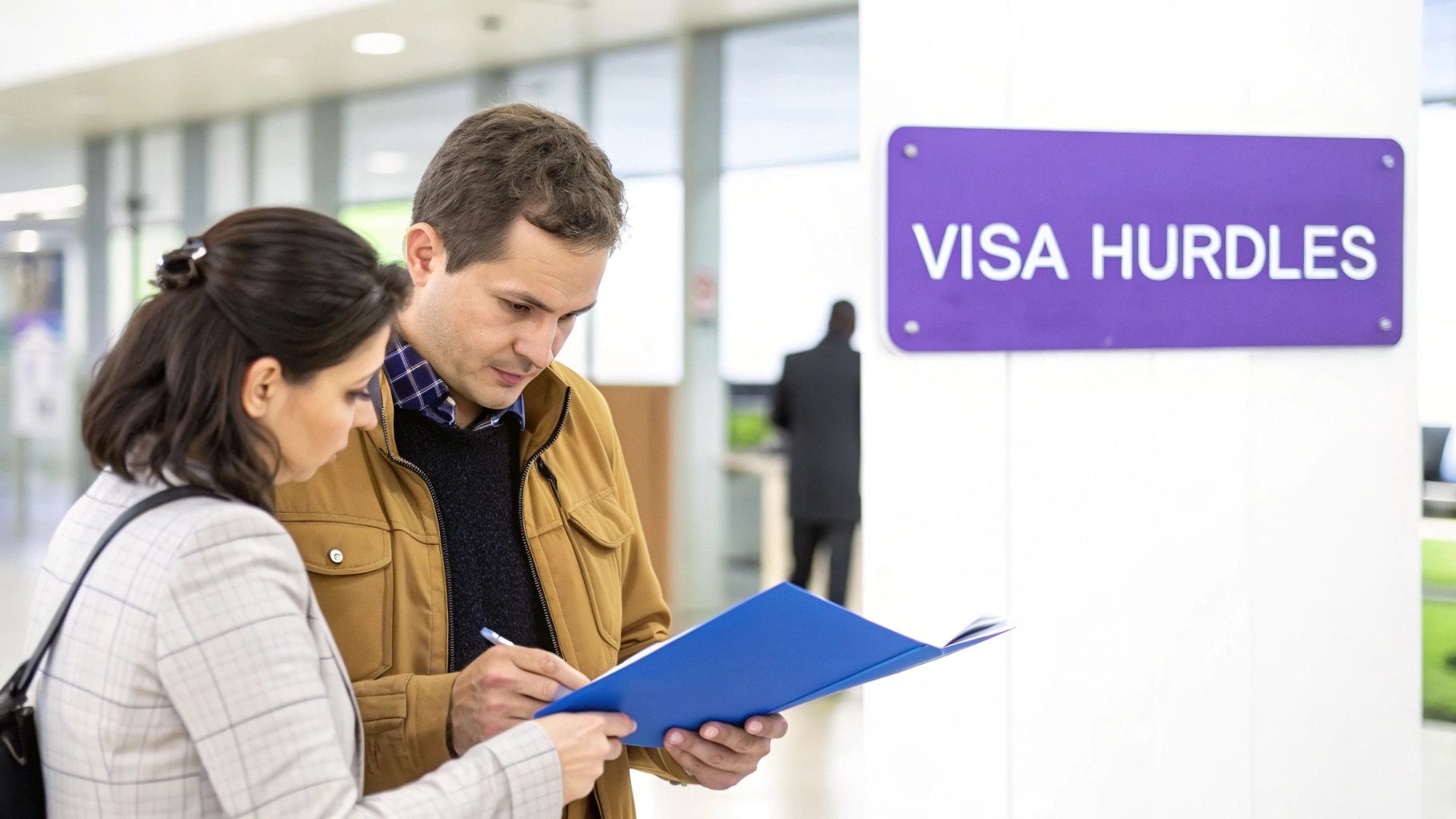
Sometimes, the hurdles are small—a simple request for an extra document. Other times, they’re systemic issues that affect thousands of applicants all at once. Think of this section as your contingency plan, a guide to what can go wrong and how you can stay one step ahead.
Understanding Delays and Policy Changes
The US visa system is constantly evolving, and changes can happen with very little warning. New screening procedures, like deeper checks on social media, can be rolled out, causing interviews to pause while consular staff get up to speed. This creates a ripple effect, leading to massive backlogs that can take months to clear.
A perfect example of this happened recently. In May 2025, a month-long freeze on visa interviews was put in place to implement new screening rules. The result? The U.S. issued 12,689 fewer F-1 visas and 7,000 fewer J-1 visas compared to the same time last year. This shows just how directly policy shifts can throw a wrench in the plans of thousands of applicants, as broken down in a recent analysis of student visa trends.
Administrative Processing: One of the most common delays you might hear about is "administrative processing." This isn't a rejection. It just means your application needs a closer look, a process that can take anywhere from a few weeks to several months with no clear end in sight.
Proactive Strategies for a Smoother Process
While you can’t control government policy, you can absolutely control how you prepare. Being proactive is your best defense against getting caught off guard by unexpected delays.
- Apply Well in Advance: This is the single most important thing you can do. Starting your application long before you plan to travel gives you a cushion to absorb any holdups.
- Stay Informed: Keep an eye on the website of the specific U.S. embassy or consulate where you’re applying. They post the latest updates on wait times, procedural changes, and any service disruptions.
- Prepare Meticulously: Make sure your DS-160 form is flawless and all your supporting documents are complete and organized. An application that is clean and thorough is far less likely to get flagged for extra review.
If your travel plans also include the UK or Canada, it's important to understand their Electronic Travel Authorization (ETA) systems. To simplify your UK ETA application and increase your chances of approval, consider using AssistEntry’s UK ETA page — their experts guide you through the entire process, starting from just $79.
Frequently Asked Questions About US Visas
The US visa process can feel like a maze of rules and paperwork. To cut through the confusion, let’s tackle some of the most common questions travelers ask when they're getting ready to apply.
How Long Is a Tourist Visa Valid For?
This is a big one, and it trips a lot of people up. A B-1/B-2 tourist visa can be issued for up to 10 years, but that doesn't mean you can pack your bags and stay for a decade. Think of it this way:
The visa’s validity is the window of time you have to travel to the U.S. Your actual permitted stay is decided by a Customs and Border Protection (CBP) officer when you land. For most tourists, this is typically up to six months per visit.
What Are the Top Reasons for a Visa Denial?
Getting a visa denial is tough, but knowing what causes them can help you build a stronger application from the start. Most refusals come down to just a few key issues:
- Failure to Prove Nonimmigrant Intent: This is the number one reason. You have to prove to the consular officer that you have deep roots in your home country—like a good job, family, or property—and you have every intention of returning home after your visit.
- Incomplete or Inaccurate Application: Even small mistakes on your DS-160 form or forgetting a required document can get your application denied on the spot. Double-check everything.
- Insufficient Funds: You must be able to show that you can afford your entire trip without needing to work illegally in the U.S.
Can I Work on a Tourist Visa?
Let me make this crystal clear: absolutely not. A B-1/B-2 visa is strictly for tourism, visiting loved ones, or specific business activities like attending a conference.
Getting paid for work is a serious violation of your visa status. If you get caught, you could face deportation and even a lifetime ban from re-entering the United States.
Always be honest about your intentions. Consular officers are trained to spot inconsistencies between what an applicant says and what they actually plan to do.
My Visa Is in an Old, Expired Passport What Should I Do?
This is a common scenario, and thankfully, the solution is simple. If your valid U.S. visa is stuck inside a passport that has expired, there's no need to transfer it.
Just travel with both passports—your new, valid one and the old one containing the visa. You'll present both to the airline agent and the CBP officer when you arrive in the U.S. It's a standard procedure, so don't worry.
For travelers exploring options for other destinations like the UK or Canada, securing the right travel authorization is key. The UK ETA is a new requirement for many visitors, and navigating the application can be tricky. AssistEntry simplifies this process. As a trusted third-party application assistance provider, their service includes full verification and error-checking to increase your chances of approval. Services start from just $79, which covers all costs including the government fee. To avoid delays and ensure your application is perfect, consider using AssistEntry’s UK ETA page for your travel needs.
